Tiantian Feng
Developing a High-performance Framework for Speech Emotion Recognition in Naturalistic Conditions Challenge for Emotional Attribute Prediction
Jun 12, 2025Abstract:Speech emotion recognition (SER) in naturalistic conditions presents a significant challenge for the speech processing community. Challenges include disagreement in labeling among annotators and imbalanced data distributions. This paper presents a reproducible framework that achieves superior (top 1) performance in the Emotion Recognition in Naturalistic Conditions Challenge (IS25-SER Challenge) - Task 2, evaluated on the MSP-Podcast dataset. Our system is designed to tackle the aforementioned challenges through multimodal learning, multi-task learning, and imbalanced data handling. Specifically, our best system is trained by adding text embeddings, predicting gender, and including ``Other'' (O) and ``No Agreement'' (X) samples in the training set. Our system's results secured both first and second places in the IS25-SER Challenge, and the top performance was achieved by a simple two-system ensemble.
Joint ASR and Speaker Role Tagging with Serialized Output Training
Jun 12, 2025Abstract:Automatic Speech Recognition systems have made significant progress with large-scale pre-trained models. However, most current systems focus solely on transcribing the speech without identifying speaker roles, a function that is critical for conversational AI. In this work, we investigate the use of serialized output training (SOT) for joint ASR and speaker role tagging. By augmenting Whisper with role-specific tokens and fine-tuning it with SOT, we enable the model to generate role-aware transcriptions in a single decoding pass. We compare the SOT approach against a self-supervised previous baseline method on two real-world conversational datasets. Our findings show that this approach achieves more than 10% reduction in multi-talker WER, demonstrating its feasibility as a unified model for speaker-role aware speech transcription.
Developing a Top-tier Framework in Naturalistic Conditions Challenge for Categorized Emotion Prediction: From Speech Foundation Models and Learning Objective to Data Augmentation and Engineering Choices
May 28, 2025Abstract:Speech emotion recognition (SER), particularly for naturally expressed emotions, remains a challenging computational task. Key challenges include the inherent subjectivity in emotion annotation and the imbalanced distribution of emotion labels in datasets. This paper introduces the \texttt{SAILER} system developed for participation in the INTERSPEECH 2025 Emotion Recognition Challenge (Task 1). The challenge dataset, which contains natural emotional speech from podcasts, serves as a valuable resource for studying imbalanced and subjective emotion annotations. Our system is designed to be simple, reproducible, and effective, highlighting critical choices in modeling, learning objectives, data augmentation, and engineering choices. Results show that even a single system (without ensembling) can outperform more than 95\% of the submissions, with a Macro-F1 score exceeding 0.4. Moreover, an ensemble of three systems further improves performance, achieving a competitively ranked score (top-3 performing team). Our model is at: https://github.com/tiantiaf0627/vox-profile-release.
Large Language Models based ASR Error Correction for Child Conversations
May 22, 2025Abstract:Automatic Speech Recognition (ASR) has recently shown remarkable progress, but accurately transcribing children's speech remains a significant challenge. Recent developments in Large Language Models (LLMs) have shown promise in improving ASR transcriptions. However, their applications in child speech including conversational scenarios are underexplored. In this study, we explore the use of LLMs in correcting ASR errors for conversational child speech. We demonstrate the promises and challenges of LLMs through experiments on two children's conversational speech datasets with both zero-shot and fine-tuned ASR outputs. We find that while LLMs are helpful in correcting zero-shot ASR outputs and fine-tuned CTC-based ASR outputs, it remains challenging for LLMs to improve ASR performance when incorporating contextual information or when using fine-tuned autoregressive ASR (e.g., Whisper) outputs.
Vox-Profile: A Speech Foundation Model Benchmark for Characterizing Diverse Speaker and Speech Traits
May 20, 2025Abstract:We introduce Vox-Profile, a comprehensive benchmark to characterize rich speaker and speech traits using speech foundation models. Unlike existing works that focus on a single dimension of speaker traits, Vox-Profile provides holistic and multi-dimensional profiles that reflect both static speaker traits (e.g., age, sex, accent) and dynamic speech properties (e.g., emotion, speech flow). This benchmark is grounded in speech science and linguistics, developed with domain experts to accurately index speaker and speech characteristics. We report benchmark experiments using over 15 publicly available speech datasets and several widely used speech foundation models that target various static and dynamic speaker and speech properties. In addition to benchmark experiments, we showcase several downstream applications supported by Vox-Profile. First, we show that Vox-Profile can augment existing speech recognition datasets to analyze ASR performance variability. Vox-Profile is also used as a tool to evaluate the performance of speech generation systems. Finally, we assess the quality of our automated profiles through comparison with human evaluation and show convergent validity. Vox-Profile is publicly available at: https://github.com/tiantiaf0627/vox-profile-release.
Who Said What WSW 2.0? Enhanced Automated Analysis of Preschool Classroom Speech
May 15, 2025



Abstract:This paper introduces an automated framework WSW2.0 for analyzing vocal interactions in preschool classrooms, enhancing both accuracy and scalability through the integration of wav2vec2-based speaker classification and Whisper (large-v2 and large-v3) speech transcription. A total of 235 minutes of audio recordings (160 minutes from 12 children and 75 minutes from 5 teachers), were used to compare system outputs to expert human annotations. WSW2.0 achieves a weighted F1 score of .845, accuracy of .846, and an error-corrected kappa of .672 for speaker classification (child vs. teacher). Transcription quality is moderate to high with word error rates of .119 for teachers and .238 for children. WSW2.0 exhibits relatively high absolute agreement intraclass correlations (ICC) with expert transcriptions for a range of classroom language features. These include teacher and child mean utterance length, lexical diversity, question asking, and responses to questions and other utterances, which show absolute agreement intraclass correlations between .64 and .98. To establish scalability, we apply the framework to an extensive dataset spanning two years and over 1,592 hours of classroom audio recordings, demonstrating the framework's robustness for broad real-world applications. These findings highlight the potential of deep learning and natural language processing techniques to revolutionize educational research by providing accurate measures of key features of preschool classroom speech, ultimately guiding more effective intervention strategies and supporting early childhood language development.
Ranking-aware Continual Learning for LiDAR Place Recognition
May 12, 2025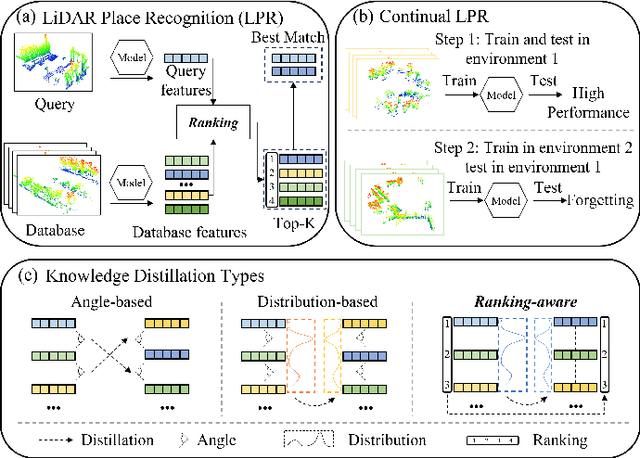
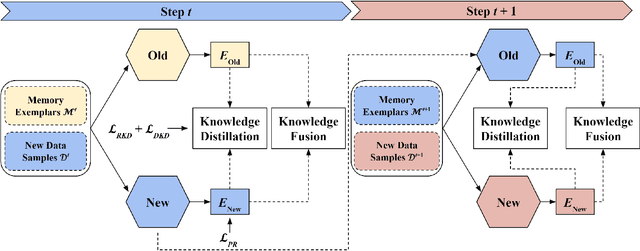
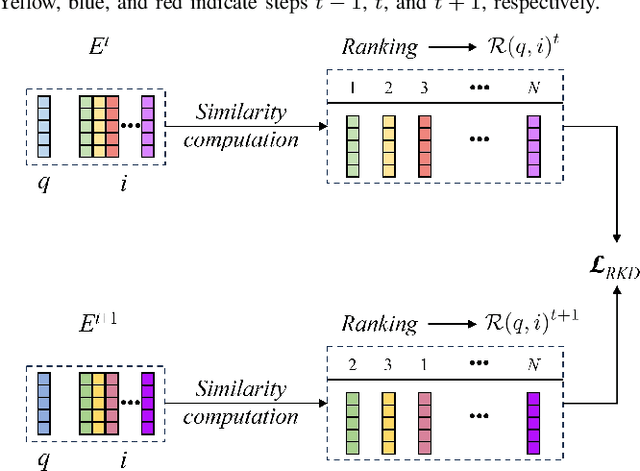
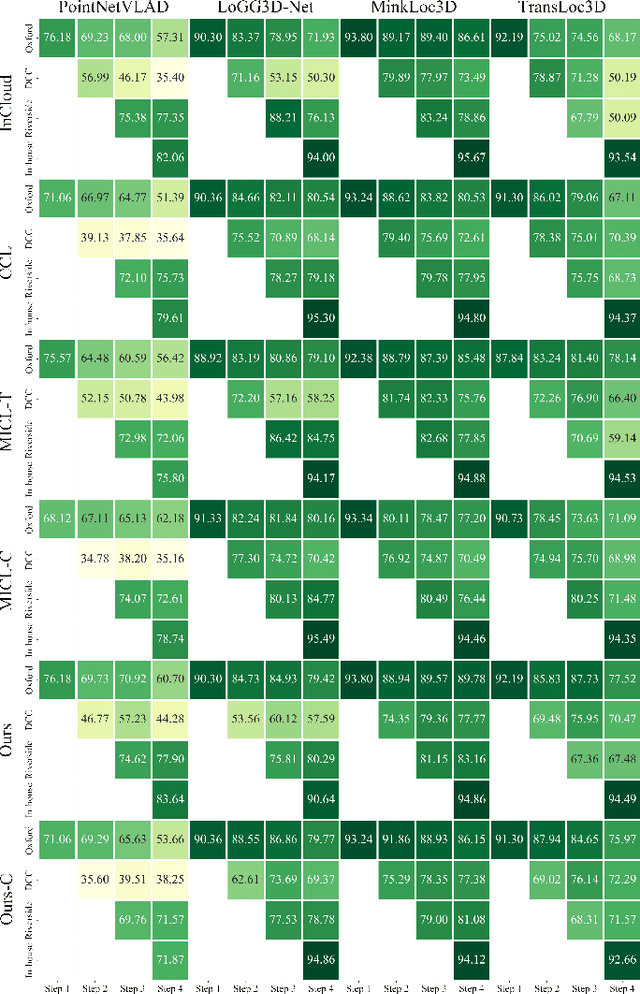
Abstract:Place recognition plays a significant role in SLAM, robot navigation, and autonomous driving applications. Benefiting from deep learning, the performance of LiDAR place recognition (LPR) has been greatly improved. However, many existing learning-based LPR methods suffer from catastrophic forgetting, which severely harms the performance of LPR on previously trained places after training on a new environment. In this paper, we introduce a continual learning framework for LPR via Knowledge Distillation and Fusion (KDF) to alleviate forgetting. Inspired by the ranking process of place recognition retrieval, we present a ranking-aware knowledge distillation loss that encourages the network to preserve the high-level place recognition knowledge. We also introduce a knowledge fusion module to integrate the knowledge of old and new models for LiDAR place recognition. Our extensive experiments demonstrate that KDF can be applied to different networks to overcome catastrophic forgetting, surpassing the state-of-the-art methods in terms of mean Recall@1 and forgetting score.
Convex Hull-based Algebraic Constraint for Visual Quadric SLAM
Mar 03, 2025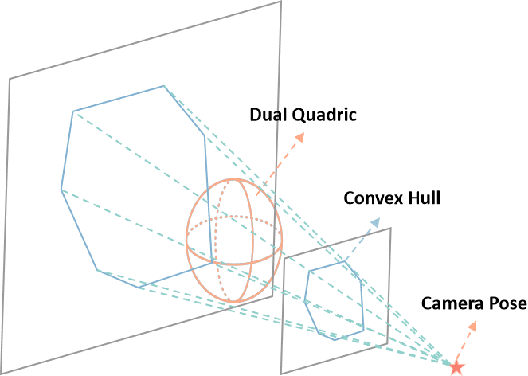
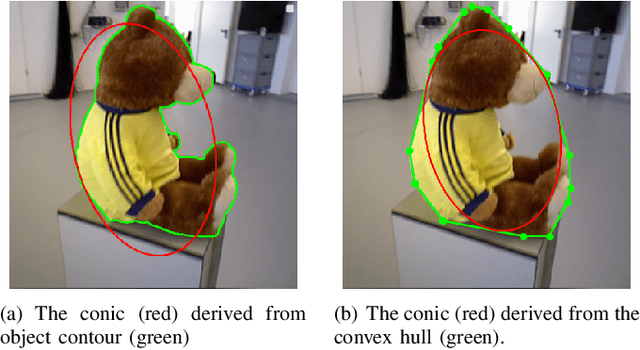
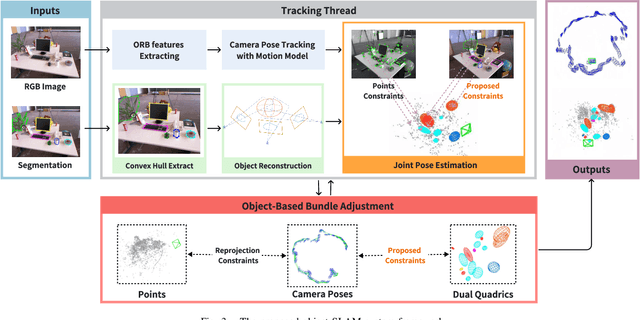
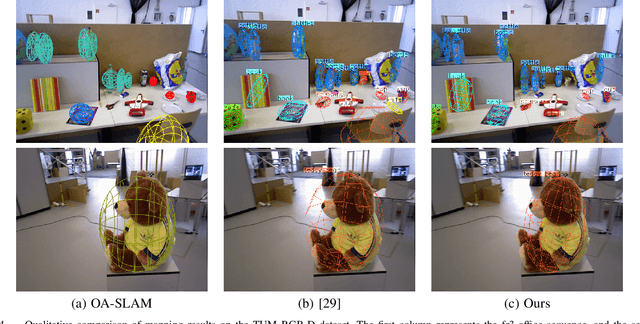
Abstract:Using Quadrics as the object representation has the benefits of both generality and closed-form projection derivation between image and world spaces. Although numerous constraints have been proposed for dual quadric reconstruction, we found that many of them are imprecise and provide minimal improvements to localization.After scrutinizing the existing constraints, we introduce a concise yet more precise convex hull-based algebraic constraint for object landmarks, which is applied to object reconstruction, frontend pose estimation, and backend bundle adjustment.This constraint is designed to fully leverage precise semantic segmentation, effectively mitigating mismatches between complex-shaped object contours and dual quadrics.Experiments on public datasets demonstrate that our approach is applicable to both monocular and RGB-D SLAM and achieves improved object mapping and localization than existing quadric SLAM methods. The implementation of our method is available at https://github.com/tiev-tongji/convexhull-based-algebraic-constraint.
Enhancing Listened Speech Decoding from EEG via Parallel Phoneme Sequence Prediction
Jan 08, 2025



Abstract:Brain-computer interfaces (BCI) offer numerous human-centered application possibilities, particularly affecting people with neurological disorders. Text or speech decoding from brain activities is a relevant domain that could augment the quality of life for people with impaired speech perception. We propose a novel approach to enhance listened speech decoding from electroencephalography (EEG) signals by utilizing an auxiliary phoneme predictor that simultaneously decodes textual phoneme sequences. The proposed model architecture consists of three main parts: EEG module, speech module, and phoneme predictor. The EEG module learns to properly represent EEG signals into EEG embeddings. The speech module generates speech waveforms from the EEG embeddings. The phoneme predictor outputs the decoded phoneme sequences in text modality. Our proposed approach allows users to obtain decoded listened speech from EEG signals in both modalities (speech waveforms and textual phoneme sequences) simultaneously, eliminating the need for a concatenated sequential pipeline for each modality. The proposed approach also outperforms previous methods in both modalities. The source code and speech samples are publicly available.
MVC-VPR: Mutual Learning of Viewpoint Classification and Visual Place Recognition
Dec 13, 2024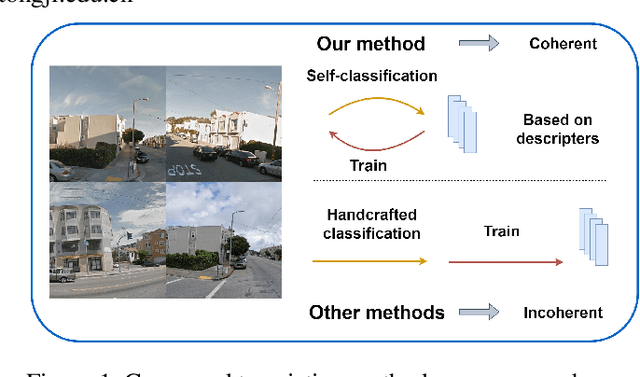
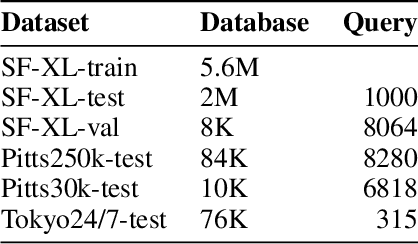
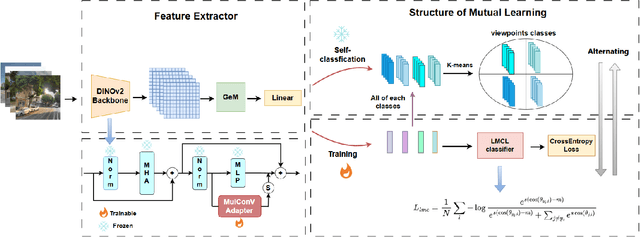

Abstract:Visual Place Recognition (VPR) aims to robustly identify locations by leveraging image retrieval based on descriptors encoded from environmental images. However, drastic appearance changes of images captured from different viewpoints at the same location pose incoherent supervision signals for descriptor learning, which severely hinder the performance of VPR. Previous work proposes classifying images based on manually defined rules or ground truth labels for viewpoints, followed by descriptor training based on the classification results. However, not all datasets have ground truth labels of viewpoints and manually defined rules may be suboptimal, leading to degraded descriptor performance.To address these challenges, we introduce the mutual learning of viewpoint self-classification and VPR. Starting from coarse classification based on geographical coordinates, we progress to finer classification of viewpoints using simple clustering techniques. The dataset is partitioned in an unsupervised manner while simultaneously training a descriptor extractor for place recognition. Experimental results show that this approach almost perfectly partitions the dataset based on viewpoints, thus achieving mutually reinforcing effects. Our method even excels state-of-the-art (SOTA) methods that partition datasets using ground truth labels.
 Add to Chrome
Add to Chrome Add to Firefox
Add to Firefox Add to Edge
Add to Edge